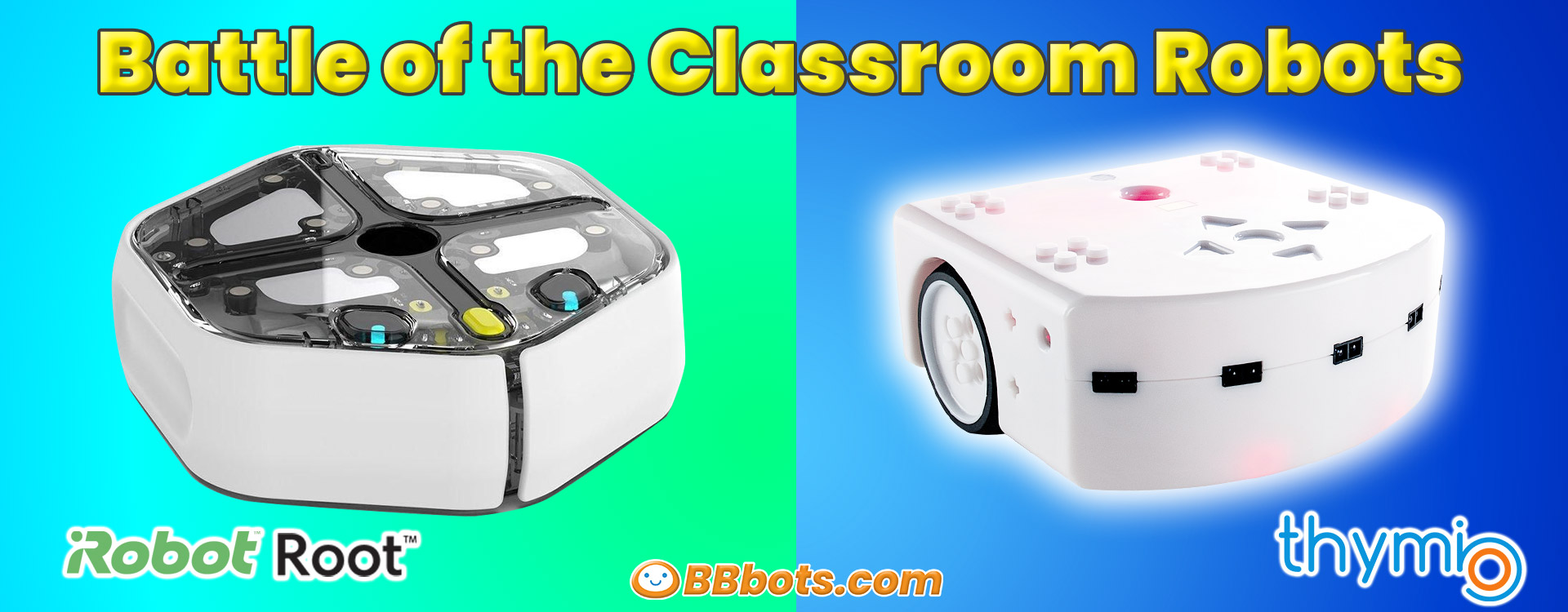Comparing two popular classroom educational mobile robots: Thymio II Wireless and iRobot Root Lite (rt0)
In today’s educational landscape, robots have become more than just tools for teaching coding and computational thinking—they are gateways to a new form of interactive learning. As technology progresses, the market is full of educational robots including Mobsya’s Thymio II Wireless and the iRobot Root Lite (rt0), each boasting a range of capabilities that promise to captivate and educate young minds.
However, not all robots are created equal. While some may be little more than high-tech toys with limited educational value, others are designed to be true programming powerhouses, capable of keeping students engaged through meaningful and complex challenges. Today we’ll compare two such educational robots: Thymio II Wireless and the iRobot Root Lite (rt0).
Choosing the right educational robot is important. Educators must weigh many factors: the age range of the students, the cost of investment, the types of sensors and interactivity offered, the programming languages supported, and the level of assembly required. Some robots such as Thymio II Wireless and the iRobot Root Lite (rt0) are ready to inspire right out of the box, requiring no prior programming experience, which can be a significant advantage in classrooms with mixed ages and skill levels.
Others robots offer a deep dive into the world of robotics, requiring a more hands-on approach that can be invaluable for older or more advanced students. The key is finding a balance—selecting a robot that not only fits the budget but also meets educational objectives and grows with the students’ abilities.
Introducing Thymio II Wireless Robot (Mobsya – Switzerland)
Thymio II is built to be tough and flexible for all ages and skill levels
Introducing iRobot Root Lite (rt0) (USA)
| Feature |  iRobot Root rt0 iRobot Root rt0 |
 Thymio II Wireless Thymio II Wireless |
|---|---|---|
| Recommended Ages | 6+ | 6+ (3+ with adult supervision) |
| Price (JP) | 24,800 yen | 24,800 yen (BBbots.com) |
| Can Use Without Computer/Tablet | ||
| Free Lesson PDFs Available | Thymio Challenge Programming Cards / MindMission Projects | |
| Operating Systems | Android, Chrome, Windows, iOS, macOS | Android, Chrome, Windows, iOS, macOS, Linux |
| Programming Languages | ||
| No-Code / No-Screen Discovery Modes |
6 Modes | |
| Block Programming | ||
| Blockly | ||
| Scratch | ||
| Text Programming | Python, Swift | Python, Aseba |
| AI Trainable | Yes, with additional software | |
| Sensors/Motors/LEDs | ||
| 3D Accelerometer | ||
| Capacitive Touch Areas | 4 | 5 |
| Sound Sensor | ||
| Speaker | ||
| Wireless Robot-to-robot Communication |
||
| Thermometer | ||
| IR Proximity Sensors | 9 Sensors | |
| IR Remote | (Sold Separately) | |
| Programmable LED Lights | 4 | 39 |
| Drive Motors | 2 | 2 |
| Bump Sensors | ||
| Light Sensor | ||
| 3D Gyroscope | ||
| Other Features | ||
| Open Source | ||
| Micro SD Slot | ||
| Drawing Pen Hole | ||
| Audio Playback | ||
| Lego Compatibility | Yes, with additional accessory | |
| Lego Technics Compatibility | Yes, with LinkVest accessory | |
| Connectivity | Bluetooth | Wireless USB dongle, Wi-Fi, USB cable |
| Battery Life | 3 – 5 hours | 3 – 5 hours |
| Charging Time | 2-3 hours | 2-3 hours |
Comparing Thymio II Wireless with iRobot Root Lite (rt0)
 iRobot Root Lite (rt0) Robot
iRobot Root Lite (rt0) Robot
- Age Range: Designed to cater to a wide range of ages, though the complexity might be more suited for older children.
- Cost-Effectiveness: May be higher-priced compared to Thymio when considering the required computers and tablets required to start, potentially limiting accessibility for some users.
- Features: iRobot Root also comes with various sensors and is designed to interact with a whiteboard surface, drawing patterns, and reacting to colors.
- Programming Languages: Offers a three-level coding interface in its companion app, suitable for beginners to advanced users.
- Compatibility: Can be used on a standard whiteboard, allowing for collaborative experiences in a classroom.
 Thymio II Wireless Classroom Robot
Thymio II Wireless Classroom Robot
- Age Range: Suitable for ages 3 to 100, Thymio offers a broad educational appeal, from early education to university-level and hobbyists.
- Cost-Effectiveness: Thymio is known for its affordability, making it a popular choice for schools and individuals on a budget.
- Features: It boasts a variety of sensors, including proximity, light, microphone, accelerometer, and temperature. Thymio has different interactive modes that do not require programming, making it immediately engaging.
- Programming Languages: Supports graphical programming with VPL (Visual Programming Language), Blockly, Scratch, as well as text-based programming with Python and Aseba.
- Compatibility: Thymio can be integrated with LEGO and other construction kits, enhancing its physical computing capabilities.
Conclusion for the battle of the robots: iRobot Root Lite (rt0) vs. Thymio II Wireless
- Age Group Versatility: Thymio’s simplicity and range of coding options make it suitable for a very wide age group. With the BBbots.com 5-Device Remote, children as young as 3 years old can start interacting with the robot. Root’s coding system is also tiered for various ages, but its specific whiteboard interaction might cater to a different educational setting.
- Cost-Effectiveness: Thymio’s ability to integrate with LEGO, the ability to be used out of the box without computers/tablets, and the wide array of built-in features may present a more cost-effective solution for educational institutions or individuals.
- Features and Educational Value: Both robots offer unique features that cater to different aspects of learning. Thymio’s array of sensors and interaction modes without the need for a screen or a whiteboard might be seen as offering more versatility in various environments, whereas Root’s unique whiteboard interaction could be highly appealing in a collaborative classroom setting.
In summary, both Thymio and iRobot Root have their own unique selling points. Thymio’s strength lies in its versatility and cost-effectiveness, making it suitable for a wider range of users and educational contexts, while iRobot Root provides a distinctive interactive experience that can be beneficial for certain teaching styles and learning objectives.














